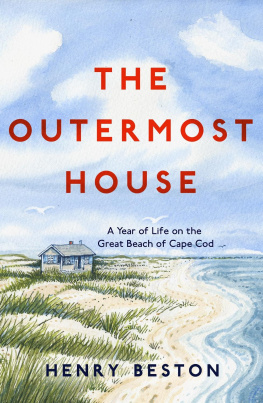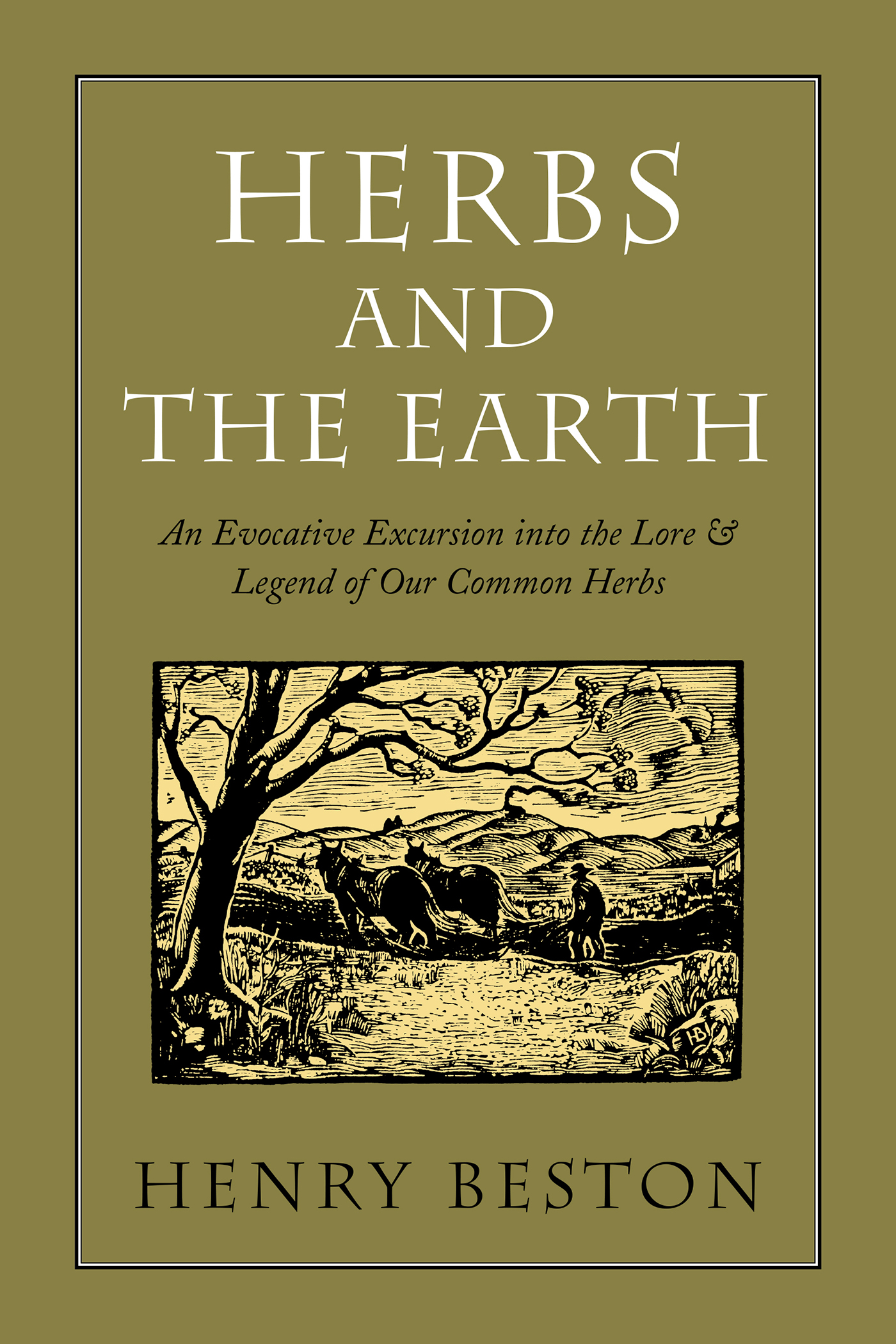books by
Henry Beston
A Volunteer Poilu ( 1916 )
Full Speed Ahead ( 1919 )
The Firelight Fairy Book ( 1919 )
The Starlight Wonder Book ( 1921 )
Book of Gallant Vagabonds ( 1925 )
The Sons of Kai ( 1926 )
The Living Age ( 1921 )
The Outermost House ( 1928 )
Herbs and the Earth ( 1935 )
American Memory ( 1937 )
Five Bears and Miranda ( 1939 )
The Tree that Ran Away ( 1941 )
Chimney Farm Bedtime Stories ( 1941 )
The St. Lawrence ( 1942 )
Northern Farm: A Chronicle of Maine ( 1948 )
White Pine and Blue Water ( 1950 )
Henry Bestons Fairy Tales ( 1952 )
This edition published in 1990 by
David R. Godine, Publisher, Inc.
Boston Massachusetts
www.godine.com
Copyright 1935 by Henry Beston
Introduction copyright 1990 by Roger B. Swain
All rights reserved. No part of this book may be used or reproduced in any manner whatsoever without written permission, except in the case of brief quotations embodied in critical articles and reviews. For more information contact
library of congress cataloging-in-publication data
Beston, Henry, 18881968 .
Herbs and the earth/Henry Beston; woodcuts by John Howard Benson.New ed.
p. cm.
isbn 978-1-56792-188-5
isbn 978-1-56792-694-1 (ebook)
Herbs. Herb gardening. HerbsFolklore. Nature. I. Title.
sb351.h5b4 1990 89-46185
581.6'3 dc 20 cip
To
Two Young Persons
Who Never Pull up or Step on
Fathers Herbs
Contents
Illustrations
Introduction
F ive chimneys anchor the roofline of the next-to-last farmhouse on East-Neck Road in Nobleboro, Maine. They replace a single massive central chimney, built with the house in 1814 , but dismantled sometime at the turn of the century in favor of multiple chimneys and individual wood stoves. New England architecture is like this. Each new generation leaves its marksan added shed, a dormer, a porch, a barn razed or raised. The accumulated layers of clapboard and shingle, wallpaper and paint, chronicle human settlement here as surely as the stonewalls that lead into the woods.
Henry Bestons long tenure at Chimney Farm began almost by accident. On a Maine visit to his friend Jake Day he went to look at a place for sale on the Neck, as the locals refer to the peninsula that divides Damariscotta Lake. This was early in 1931 , and nearly five feet of snow lay on the ground. Beston, who was something of an iconoclast in matters of dress, cut quite a figure wearing his Piccadilly blue overcoat and a pair of borrowed snowshoes as he hiked across the buried pasture and down through the old-growth hemlock and pines to the edge of the snow-covered ice.
Later, back home in Hingham, Massachusetts, he would ask his wife Elizabeth Coatsworththe poet and childrens authorwhether she would like to have a Maine farm, but he already had his answer. The hundred acres, with its woodlot partially enclosing Deep Cove, would be a sanctuary from the modern city with its violences and barbarities. And so it was until his death in 1968 , and hers in 1986 . Though the two of them would travel elsewhereto Arizona, the Yucatan, and especially the French parts of CanadaMaine was to be Henry Bestons chosen state, his chosen home. Today a massive boulder, shaded by sugar maple trees, marks the couples grave in the little burial plot just across the road.
By birth, Bestons allegiances lay still farther east. Christened Henry Beston Sheahan, he was the son of an Irish physician father and a French-Catholic mother. Born in Quincy, Massachusetts, in 1888 , he was raised bilingually and would later claim that he could think as freely in French as in English. He attended Harvard College, majored in English, and stayed in Cambridge for a masters degree before going abroad to teach at the University of Lyons. There, in the vineyards and villages of southern France, he seems to have been particularly struck by the centuries of unbroken agricultural tradition. The experience would echo years later in Maine when he wrote his wife from Chimney Farm: I heard across the lovely, wet, sunlit, autumn countryside the rumble of a farm-carts wheel and the fine challenge of a cock, and hearing them I thought of how all these earthy things carry me back to France, back to Ste. Catherine-sous-Rivire... the first place in which I encountered and knew and loved the earth.
Many years intervened, however, including the First World War with its parachute trench lights fizzing magnesium-white over trees and the drifting miles of wreckage at sea. Beston drove an ambulance and later served as a Navy correspondent in the submarine zones. His first bookA Volunteer Poilu ( 1916 )chronicled his war experiences and was published under the name of Sheahan, but shortly thereafter the author began living and writing as Henry Beston, using the surname of his maternal grandmothers family. The next decade found him back in Boston working in the Atlantic Monthly editorial offices, and on a string of books for children. These he said he wrote mostly to get the war out of his mind.
By 1926 , he was still single and had recently had a small cottage built on a fifty-acre parcel of barrier beach he owned in the town of Eastham on Cape Cod. What began as a two-week visit there turned into a year-long stay in the dunes, with his nearest neighbor the Nauset coast guard station two miles north up the beach. From his journals of that year containing his accounts of life at the edge of the surf, the pageant of birds, storms, and constellations, he wrote The Outermost House ( 1928 ). By far the most famous of Bestons books, this landmark of natural-history writing put The Focastlethe name Beston gave to his two-room cottageinto literary gazetteers right alongside Thoreaus cabin in Concord. But Beston never encouraged the comparison, saying that Thoreau had very little heart. And it must be noted that Bestons own heart belonged more to Maine than Massachusetts. Once the family owned Chimney Farm, he rarely returned to Cape Cod.
The Bestons move to Maine was a gradual one. In 1931 , Elizabeth was expecting the couples second child, and so Henry was left to supervise the next round of renovations at Chimney Farm alone: plumbing to replace the pump in the kitchen, a bathroom, and an open porch between the dining room and the kitchen ell. He also returned the original twelve-pane sashes to the windows, and repainted the fading yellow exterior a farmhouse red.
Construction completed, the family began spending every summer in Maine. They made up for the natural shortness of the season by coming early and staying late, even when it meant taking the two girls north a few weeks before school ended each year, and missing the start of school in the fall. During the off-season, they returned to Maine for a week whenever they could, switching in Portland from the Boston and Maine to the Maine Central Railroad for the ride to the flagstop in Nobleboro. A dozen years later, in 1944 , the Bestons moved north for good.













